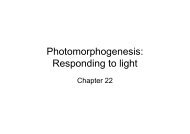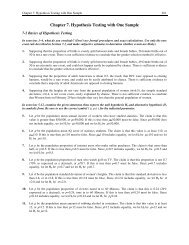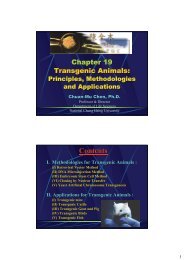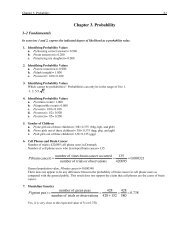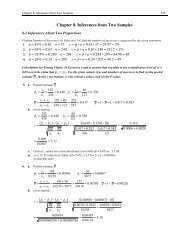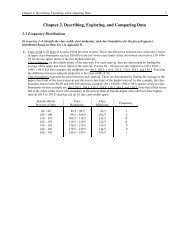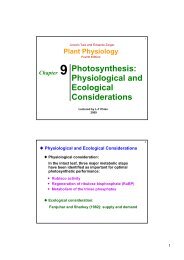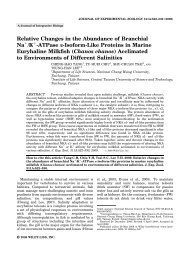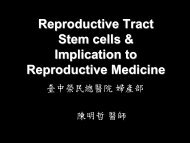Author's personal copy
Author's personal copy
Author's personal copy
Create successful ePaper yourself
Turn your PDF publications into a flip-book with our unique Google optimized e-Paper software.
<strong>Author's</strong> <strong>personal</strong> <strong>copy</strong>48 W.-K. Yang et al. / Journal of Experimental Marine Biology and Ecology 375 (2009) 41–50days (Mancera et al., 1993; Claireaux and Audet, 2000; Hsieh et al.,2003; Frisch and Anderson, 2005; Sangiao-Alvarellos et al., 2005)after shocks. Higher plasma glucose levels can be maintained over20 days after salinity shocks (Fig. 7; Woo and Chung, 1995; Morganand Iwama, 1998; Kelly et al., 1999; Claireaux and Audet, 2000; DeBoeck et al., 2000; Fiess et al., 2007). Consistently higher glucoselevels after transfer illustrated a higher energy demand for acclimatationto the new environment (Soengas et al., 1995; Arjona et al.,2007).Increased expression of HSPs including HSP90 of fish upon transfer toa hyperosmotic environment, suggests a role for HSPs in maintaining thenormal functions of proteins and cells (Iwama et al.,1999). Upon salinitychallenge, HSP90 expression varied differentially among species. HSP90expression in livers (protein amount; Deane et al., 2002) and gills(mRNA abundance; Choi and An, 2008) of black porgy was found to behigher in hypoosmotic environments (BW or FW) than in SW. However,no change in HSP90 mRNA expression was found in the livers and gills ofchinook salmon at one day after transfer from FW to SW (Oncorhynchustshawytscha; Palmisano et al., 2000). On the other hand, the branchialHSP90 mRNA expression in the gills of Atlantic salmon was raised andthen returned to baseline levels within two days after transfer from FWto SW (Pan et al., 2000). HSP90 is abundantly expressed in mosteukaryotes and it performs its role by forming a multiple proteincomplex with ATPase activity as well as cooperating with other HSPs(Wegele et al., 2004). Elevated hepatic and branchial HSP90 expressionin SW-acclimated sailfin molly might play important roles for reachinghomeostasis upon salinity challenge. More evidence such as plasmacortisol levels will be necessary to illustrate the stress response of sailfinmolly upon salinity challenge in future work.5. ConclusionEuryhaline sailfin molly is able to survive in FW, BW, and SW.Moreover, elevated plasma glucose concentrations, as well as branchialand hepatic HSP90 protein abundance, revealed that SW was stressfulthan FW to the sailfin molly. To maintain homeostasis, higher NKAactivity was necessary for ion secretion in gills of the sailfinmollyinSW(the stressful environment). Although the plasma osmolality of sailfinmolly increased with environmental salinities within a tolerated range,the MWC were constant among different salinity groups. These resultsillustrated that the sailfin molly was proved to be an efficientosmoregulator with gill NKA expression altering in response to salinitychallenge to maintain ion and water homeostasis in environments ofdifferent salinities.AcknowledgementsThe monoclonal antibody of Na + /K + -ATPase α-subunit (α5) werepurchased from the Developmental Studies Hybridoma Bank maintainedby the Department of Pharmacology and Molecular Sciences, JohnHopkins University School of Medicine, Baltimore, MD 21205, and theDepartment of Biological Sciences, University of Iowa, Iowa City, IA 52242,under Contract N01-HD-6-2915, NICHD, USA. This study was supportedby a grant from the National Science Council of Taiwan to T.H.L. (NSC 94-2311-B-005-009). [SS]ReferencesArends, R.J., Mancera, J.M., Muñoz, J.L., Wendelaar Bonga, S.E., Flik, G., 1999. The stressresponse of the gilthead sea bream (Sparus aurata L.) to air exposure and confinement.J. Endocrinol. 163, 149–157.Arjona, F.J., Vargas-Chacoff, L., Ruiz-Jarabo, I., Martín del Río, M.P., Mancera, J.M., 2007.Osmoregulatory response of Senegalese sole (Solea senegalensis) to changes inenvironmental salinity. Comp. Biochem. Physiol. A 148, 413–421.Bagherie-Lachidan, M., Wright, S.I., Kelly, S.P., 2008. Claudin-3 tight junction proteins inTetraodon nigroviridis: cloning, tissue-specific expression, and a role in hydromineralbalance. Am. J. Physiol. 294, R1638–R1647.Bashamohideen, M., Parvatheswararao, V., 1972. Adaptations to osmotic stress in thefresh-water euryhaline teleost Tilapia mossambica. IV. Changes in blood glucose,liver glycogen and muscle glycogen levels. Mar. Biol. 16, 68–74.Basu, N., Todgham, A.E., Ackerman, P.A., Bibeau, M.R., Nakano, K., Schulte, P.M., Iwama,G.K., 2002. Heat shock protein genes and their functional significance in fish. Gene295, 173–183.Berra, T.M., 2001. Freshwater Fish Distribution. In Academic Press, London, pp. 337–341.Blanco, G., Mercer, R.W., 1998. Isozymes of the Na + , K + -ATPase: heterogeneity instructure, diversity in function. Am. J. Physiol. 275, F633–F650.Bond,C.E.,1996.BiologyofFishes,2nded.SaundersCollegePub,NewYork,pp.404–412. 425.Bruslé, J., Anadon, G.G., 1996. The structure and function of fish liver. In: Munshi, J.S.D.,Dutta, H.M. (Eds.), Fish Morphology: Horizon of new research. In Science Publishers,New York, pp. 77–93.Buckley, B.A., Gracey, A.Y., Somero, G.N., 2006. The cellular response to heat stress in thegoby Gillichthys mirabilis: a cDNA microarray and protein-level analysis. J. Exp. Biol.209, 2660–2677.Bystriansky, J.S., Richards, J.G., Schulte, P.M., Ballantyne, J.S., 2006. Reciprocal expressionof gill Na + /K + -ATPase α-subunit isoforms α1a and α1b during seawateracclimation of three salmonid fishes that vary in their salinity tolerance. J. Exp.Biol. 209, 1848–1858.Cara, J.B., Aluru, N., Moyano, F.J., Vijayan, M.M., 2005. Food-deprivation induces HSP70and HSP90 protein expression in larval gilthead sea bream and rainbow trout.Comp. Biochem. Physiol. B 142, 426–431.Cataldi, E., Mandich, A., Ozzimo, A., Cataudella, S., 2005. The interrelationships betweenstress and osmoregulation in a euryhaline fish, Oreochromis mossambicus. J. Appl.Ichthyol. 21, 229–231.Chang, J.C., Wu, S.M., Tseng, Y.C., Lee, Y.C., Baba, O., Hwang, P.P., 2007. Regulation of glycogenmetabolism in gills and liver of the euryhaline tilapia (Oreochromis mossambicus)during acclimation to seawater. J. Exp. Biol. 210, 3494–3504.Choi, C.Y., An, K.W., 2008. Cloning and expression of Na + /K + -ATPase and osmotic stresstranscription factor 1 mRNA in black porgy, Acanthopagrus schlegeli during osmoticstress. Comp. Biochem. Physiol. B 149, 91–100.Choi, C.Y., An, K.W., Choi, Y.K., Jo, P.G., Min, B.H., 2008. Expression of warm temperatureacclimation-related protein 65-kDa (Wap65) mRNA, and physiological changeswith increasing water temperature in black porgy, Acanthopagrus schlegeli. J. Exp.Zool. A 309, 206–214.Claireaux, G., Audet, C., 2000. Seasonal changes in the hypo-osmoregulatory ability ofthe brook charr: the role of environmental factors. J. Fish Biol. 56, 347–373.Dang, Z., Lock, R.A.C., Flik, G., Bonga, S.E.W., 2000. Na + /K + -ATPase immunoreactivity inbranchial chloride cells of Oreochromis mossambicus exposed to copper. J. Exp. Biol.203, 379–387.De Boeck, G., Vlaeminck, A., Van der Linden, A., Blust, R., 2000. The energy metabolismof common carp (Cyprinus carpio) when exposed to salt stress: an increase inenergy expenditure or effects of starvation? Physiol. Biochem. Zool. 73, 102–111.De Jong, L., Moreau, X., Jean, S., Scher, O., Thiéry, A., 2006. Expression of the heat shockprotein Hsp70 in chloride target cells of mayfly larvae from motorway retentionpond: a biomarker of osmotic shock. Sci. Total Environ. 366, 164–173.Deane, E.E., Woo, N.Y.S., 2004. Differential gene expression associated with euryhalinityin sea bream (Sparus sarba). Am. J. Physiol. 287, R1054–R1063.Deane, E.E., Kelly, S.P., Luk, J.C.Y., Woo, N.Y.S., 2002. Chronic salinity adaptationmodulates hepatic heat shock protein and insulin-like growth factor I expression inblack sea bream. Mar. Biotechnol. 4, 193–205.Dietz, T.J., 1994. Acclimation of the threshold induction temperatures for 70-kDa and 90-kDaheat shock proteins in the fish Gillichthys mirabilis.J.Exp.Biol.188,333–338.Diouf, B., Rioux, P., Blier, P.U., Rajotte, D., 2000. Use of brook char (Salvelinus fontinalis)physiological responses to stress as a teaching exercise. Adv. Physiol. Educ. 23, 18–23.Doneen, B.A., 1981. Effects of adaptation to sea water, 170% sea water and to fresh wateron activities and subcellular distribution of branchial Na + ,K + -ATPase, low- andhigh-affinity Ca ++ -ATPase, and ouabain-insensitive ATPase in Gillichthys mirabilis.J. Comp. Physiol. 145, 51–61.Eddy, F.B., Bath, R.N., 1979. Ionic regulation in rainbow trout (Salmo gairdneri) adaptedto fresh water and dilute sea water. J. Exp. Biol. 83, 181–192.Evans, D.H., Piermarini, P.M., Potts, W.T.W., 1999. Ionic transport in the fish gill epithelium.J. Exp. Zool. 283, 641–652.Evans,D.H.,Piermarini,P.M.,Choe,K.P.,2005.Themultifunctionalfish gill: dominant site ofgas exchange, osmoregulation, acid-base regulation, and excretion of nitrogenous waste.Physiol. Rev. 85, 97–177.Feder,M.E.,Hofmann,G.E.,1999.Heat-shockproteins,molecularchaperones,andthestressresponse:evolutionaryandecologicalphysiology.Annu.Rev.Physiol.61,243–282.Fiess, J.C., Kunkel-Patterson, A., Mathias, L., Riley, L.G., Yancey, P.H., Hirano, T., Grau, E.G.,2007. Effects of environmental salinity and temperature on osmoregulatory ability,organic osmolytes, and plasma hormone profiles in the Mozambique tilapia(Oreochromis mossambicus). Comp. Biochem. Physiol. A 146, 252–264.Fiol, D.F., Kültz, D., 2007. Osmotic stress sensing and signaling in fishes. FEBS J. 274,5790–5798.Freire, C.A., Amado, E.M., Souza, L.R., Veiga, M.P., Vitule, J.R., Souza, M.M., Prodocimo, V.,2008. Muscle water control in crustaceans and fishes as a function of habitat,osmoregulatory capacity, and degree of euryhalinity. Comp. Biochem. Physiol. A149, 435–446.Frisch, A., Anderson, T., 2005. Physiological stress responses of two species of coral trout(Plectropomus leopardus and Plectropomus maculatus). Comp. Biochem. Physiol. A 140,317–327.Froese, R., Pauly, D. (Eds.), 2008. FishBase. World Wide Web electronic publication.www.fishbase.org, version (09/2008).Gonzalez, R.J., Cooper, J., Head, D., 2005. Physiological responses to hyper-saline watersin sailfin mollies (Poecilia latipinna). Comp. Biochem. Physiol. A 142, 397–403.




